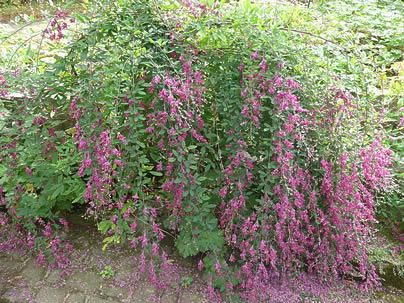Bush Clover (Lespedeza thunbergii) is a flowering shrub with arching branches and a semi-woody texture, native to China and Japan. It can be deciduous or evergreen, depending on the climate in which it is cultivated. In temperate climates with intense winter cold, it sheds its leaves in the season, regrowing from the roots in spring. In some cases, the plant may die, necessitating replanting.
In subtropical climates, it remains evergreen, only reducing its vegetative growth in winter. Rapidly growing, it reaches about 6.6 feet in height (2 meters) with a diameter of 9.8 feet (3 meters). Its long, arching branches give the overall appearance a cascading effect. The leaves are trifoliate and alternate, arranged spirally along the branches, with blue-green, elliptical to lanceolate leaflets.
It blooms in late summer and early fall, adorning the branches with numerous dark pink flowers. The inflorescences are panicles of racemes, with flowers resembling those of peas. Notable cultivars include ‘Edo Shibori’ with bicolor flowers, ‘VA-70’ and ‘Amquail’ selected for their resistance and to provide shelter and food for wildlife, ‘White Fountain’ with white flowers, and ‘Gibraltar’ with pink flowers. The flowers produce abundant nectar and are attractive to bees and butterflies. The fruit is a legume type with black seeds.

In the garden, Bush Clover is ideal for solitary use or in rows, enhancing its cascading form. It stands out when placed alone on well-maintained lawns, crowning walls or pergolas, or in combination with other species, especially in English or cottage-style gardens.
The fine texture of the foliage, the unusual shape, and the profusion of late-blooming flowers make this species particularly appealing in landscaping. It is also suitable for crowning walls and slopes, as well as beautifying central plant beds along avenues. Due to its size, it is suitable for spacious areas and requires minimal maintenance, limited to drastic pruning at the end of winter and fertilization during the growth and flowering period.
It should be cultivated in full sun or partial shade, in fertile, well-drained soils enriched with organic matter and regularly irrigated in the first year of establishment. Once well-established, it becomes resistant to short periods of drought, tolerates cold and light frosts, and is resistant to pests and diseases. Propagation can be done through seeds, cuttings, layering, and by separating naturally formed seedlings around the mother plant due to branches that touch the ground and root.


